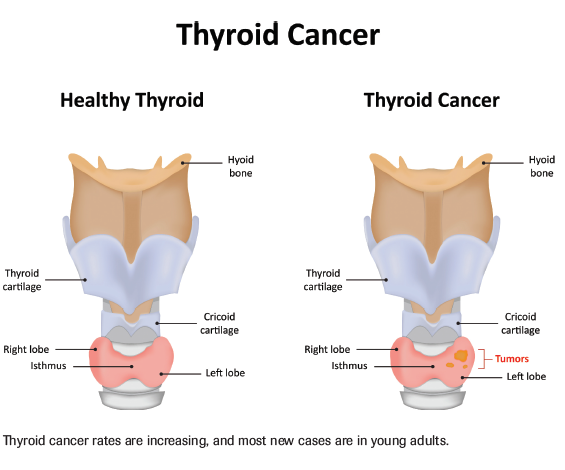Monitoring for Thyroid Cancer Recurrence
Alan N. Peiris, MD spoke with ONCOLOGY about guidelines and strategies for treating patients who have had thyroid cancer.

Alan N. Peiris, MD

Alan N. Peiris, MD spoke with ONCOLOGY about guidelines and strategies for treating patients who have had thyroid cancer.
Q: First, could you talk about the importance of monitoring for thyroid cancer recurrence in those patients who have been previously diagnosed and treated for thyroid cancer?
Dr. Peiris: I think that it is important to monitor for recurrence. To put this in context, we should probably say that there are many different types of thyroid cancer. Some of these are managed more by oncologists. For example, patients with lymphomas generally end up going to oncologists. Whereas most patients with other types of thyroid cancer––certainly the most common ones––come to the endocrinologist.
Monitoring is a huge topic, so I will focus my comments on differentiated thyroid cancers, namely papillary thyroid cancer and follicular thyroid cancer. In other words, they are cancerous but they still process iodine somewhat similarly to normal thyroid tissue. These differentiated thyroid cancers account for the vast majority of thyroid cancers, up to maybe 70% to 80%, so monitoring often comes up in relation to them. It is very important for patients and physicians to consider monitoring. We can always talk about what’s coming down the pipeline, but currently after intervention, we follow these patients carefully with blood work, thyroglobulin measurements, and then consider imaging techniques.
One area of controversy comes from the fact that most of these differentiated thyroid cancers have really good outcomes. Sometimes, the scientific data to back up certain approaches have been hard to validate because people generally do well with these differentiated thyroid cancers and this spills over into monitoring.
The method of monitoring depends on the type of thyroid cancer and the staging. It is difficult to be very specific without having more detailed information. I would say that anyone with thyroid cancer should have some degree of monitoring.
The American Cancer Society estimates that in 2019, there will be 52,070 new cases of thyroid cancer and about 2,170 deaths from thyroid cancer. Women are more likely to get thyroid cancer. It is the most rapidly increasing cancer in the United States, largely due to increase imaging.
There are several forms of thyroid cancer. Moreover, rarely other malignancies can metastasize to the thyroid, so-called secondary involvement of the thyroid gland. In this commentary, we have chosen to focus on the more common thyroid cancers. These more common primary (originating in the thyroid) forms of thyroid cancer are differentiated in cell type and generally have a good prognosis. However, the less common forms such as anaplastic thyroid cancer are undifferentiated and can result in a rapid demise. Treatments vary depending on the type of thyroid cancer. Papillary thyroid cancer along with follicular thyroid cancer account for most thyroid cancers. These differentiated thyroid cancers are generally treated with surgery initially. The extent of the surgery depends on the size of the lesion and evidence of involvement of adjacent tissues. Surgery may be followed by radioactive iodine to destroy the remnant or residual thyroid tissue. Thyroid-stimulating hormone (TSH) is also monitored because a suppressed TSH is preferred and is believed to make recurrence of differentiated thyroid cancer less likely. Potentially, a sustained high TSH could increase risk of recurrence of differentiated thyroid cancer. It is important to monitor for recurrence especially in the first 5 years; however, recurrence can rarely occur many years later.
Q: What are the current routine ways to monitor for thyroid cancer recurrence? Specifically, for each subtype, what monitoring is appropriate?
Dr. Peiris: It is helpful to focus on the differentiated thyroid cancers as those account for most of the thyroid cancers. For the most common form of thyroid cancer, we should bear in mind that we do it a couple of ways. We look at thyroglobulin measurements and antithyroglobulin antibody measurement as a blood marker. Then we do imaging, usually a neck ultrasound, to ensure that there is no recurrence either in the region of the thyroid bed or in the lymph nodes. Most of the recurrences tend to come up in the head and neck area.
For the most common differentiated thyroid (papillary and follicular) cancers, monitoring is done through imaging, including neck ultrasound examinations. Suspicious ultrasound findings can be further evaluated using fine-needle aspiration, with the needle washout fluid also tested for thyroglobulin. Other imaging modalities could include whole body nuclear medicine scanning using radioactive iodine, but CT or MRI is sometimes used. Sometimes these differentiated thyroid cancers, which are usually iodine avid much like normal thyroid tissue, lose that ability, which is generally not a favorable sign. In these situations, imaging with positron emission tomography (PET) may be appropriate. In differentiated thyroid cancers, we also monitor serum thyroglobulin.
Q: Are there other tests that should be done in parallel to thyroglobulin levels in the blood?
Dr. Peiris: Certainly, yes. With the differentiated thyroid cancers, we monitor using a thyroid function test as these patients are normally on thyroxine replacement because they’ve either had their thyroid cancer taken out or were given radioactive iodine. We monitor thyroid function to make sure that the TSH, which is a hormone released from the pituitary, is kept relatively suppressed so it doesn’t stimulate growth of the thyroid. We also monitor for the thyroglobulin with antibodies and imaging, the frequency of which really depends on the individual patient. The imaging may be ultrasound, which is a very easy thing to do. Sometimes (but rarely), imaging involves CT scans, MRIs, or nuclear medicine studies. It is important to remember that these cancers process iodine, so we can use radioactive iodine not only to image these cancers but also to treat them because they are destroyed by radioactive iodine. Now, in some situations these cancers are initially responsive to radioactive iodine but then later become unresponsive to radioactive iodine. At that point, we may use other imaging methodologies like PET-CT scans.
Q: Are there additional ways recurrence of thyroid cancer can be detected that are currently being developed?
Dr. Peiris: There are several. I also want to say that although we are very dependent on thyroglobulin measurements and imaging, one should always remember that examining the patient is a time-honored tradition and that should not be de-emphasized. All of the labs and radiology results should be placed in the context of talking to your patients and examining them. As for the question of new markers, we’ve learned a lot over the past few years. We know thyroid cancer is being picked up much more often now, and we’ve also learned that we may have been overly aggressive in treating some forms of differentiated thyroid cancer. The whole purpose is to identify people who are at higher likelihood of recurrence. That’s where the efforts are being focused because it is clear that some patients have greater risks of not only developing differentiated thyroid cancer but also recurrence.
Markers, if they can provide synergy to the current testing, are a very exciting potential future development. There’s a lot there, but these tests have not been fully validated. One is looking at protein, microRNAs, and nucleic acid as markers that may provide some utility in picking up the recurrence. We’ve looked at using ultrasound in different ways. Ultrasound has been used with a technique called elastography for detecting fibrosis in the liver and breast abnormalities. Researchers are looking at that modality to pick up cervical lymph node involvement. Cervical nodes are present in everyone and they often get larger during, for example, a respiratory tract infection. We always have to stop and think whether this enlargement is temporary and related to infection or whether it might mean recurrence of thyroid cancer. In the past, we’ve occasionally had the need to sample these lymph nodes through fine-needle aspiration and measure thyroglobulin in the lymph nodes because normal lymph nodes should not have thyroglobulin. Thyroglobulin is confined to the thyroid gland and thyroid cancer. We are also looking at genetic studies to identify mutations such as the BRAF mutation, which may help risk-stratify papillary thyroid cancer.
A lot of different methods and technologies are being looked at, but I’m not sure they are ready for primetime because they need additional work. But it certainly is a welcome opportunity to improve monitoring of patients. The whole purpose of monitoring is based on an individualized risk assessment. Currently, we could do with some help with newer technologies, but it’s important to realize that not everyone gets the same risk assessment. Therefore, it’s up to the individual clinicians to assess all of the data and determine that risk and then determine how frequent monitoring should be.
Novel markers such as circulating microRNAs and nucleic acids may replace thyroglobulin or have the option of providing additional tests to confirm likelihood of recurrence. However, they need to be standardized after validation. Elevated neutrophil-to-lymphocyte ratio correlates with tumor size and extrathyroidal extension. Elastography, used in liver and breast disease, may offer better ultrasound detection of abnormalities in lymph nodes. Identifying BRAF mutations may help risk-stratify papillary thyroid cancer. Even a reduced leukocyte telomere length may identify individuals at high risk for papillary thyroid cancer.
Q: Finally, in the context of monitoring recurrence, could you briefly highlight advances as far as treatment and diagnosis? What are the prospects for patients who are treated for thyroid cancer?
Dr. Peiris: This discussion has focused mainly on differentiated thyroid cancers, which are basically papillary and follicular variants. I should point out that there are some very aggressive types such as anaplastic thyroid cancers in which the patient is usually dead within 6 months. My comments don’t relate to that type of cancer. There is a saying in endocrinology that if you have to have cancer, have a skin cancer or a differentiated thyroid cancer because many of these patients live a full and unrestricted life span. Differentiated thyroid cancer has a very, very good outlook. Patients can be treated with surgery, radioactive iodine, and very rarely, with external radiation. A new series of drugs is coming out called tyrosine kinase inhibitors. And researchers are working on newer drugs that may help. The traditional standby has been surgery and radioactive iodine and, as I alluded to previously, there’s a consensus that maybe too much therapy was given in the past and we didn’t need to be as aggressive as we were in managing early, limited papillary thyroid cancer. A lot of my patients have a normal life span and they do really very well.
Key Question
You and your colleagues recently wrote about monitoring by tracking thyroglobulin levels in the blood. Could you talk about the biology of this biomarker and how frequently it should be checked in patients?
Dr. Peiris: Thyroglobulin is found in the normal thyroid and released into the blood. Differentiated thyroid cancers also have the ability to make this. Ideally, once the patient has had an intervention for papillary or follicular thyroid cancer, the thyroglobulin level should be really low because there’s no thyroid tissue left, as the patient has had surgery and/or radioactive iodine. The cancer is basically no longer there. If we see a thyroglobulin level, it tells us that there is some normal thyroid tissue or thyroid cancer. And if the level started off low and then starts increasing, that is concerning because the level should be very, very low.
We have a couple of ways that we look at this. We measure the levels of thyroglobulin in the blood through immunoassays. The thyroglobulin levels should always be measured with the antithyroglobulin antibody, because if you have proteins or antibodies that bind thyroglobulin, you can have misleading results. How often we do this really depends on the context of the patient. If someone is very stable, if the resection margins of the cancer are free and clear, and if the staging is appropriate and the patient has positive outlook factors, we may not do the monitoring and testing as frequently. If, on the other hand, we see a patient, examine them, and find a lymph node, we need to do it more frequently. I would stress that the biggest service we can do for our patients with thyroid cancer is to place their condition in context. In other words, not everyone will get the same management and that’s as it should be. Some people are going to be higher risk and need more frequent monitoring, and other people will be at very low risk and their interval for monitoring will be much longer.
Thyroglobulin is produced by normal thyroid tissue and differentiated thyroid cancers and is measured in blood. Thyroglobulin measurement is most useful if done when the TSH is high. A high TSH is seen after thyroid removal if thyroxine replacement is not adequate or from injection of biosynthetic TSH. If thyroglobulin levels are low even in the presence of stimulation by a raised TSH, this is very reassuring and indicates absence of recurrence in papillary and follicular thyroid cancers (differentiated thyroid cancers). More recent sensitive thyroglobulin assays may detect much lower levels of serum thyroglobulin and provide similar information to the values done previously through TSH stimulation. A rising level of serum thyroglobulin may indicate a recurrence, even if imaging is negative. Several steps may occur concurrently in the monitoring for recurrence in differentiated thyroid cancers. These steps include imaging studies and blood work. In order to fully assess the significance of serum thyroglobulin, antithyroglobulin antibodies are requested at the same time. The presence of thyroglobulin antibodies can confound thyroglobulin estimates. Rarely, a rising titer of antithyroglobulin antibodies may indicate a recurrence of differentiated thyroid cancer. The frequency of testing depends on the individual patient and can vary between several months and 6 months or even longer. Periodic risk assessment may allow the change in a patient’s status to higher or lower risk.
Financial Disclosure:Dr. Peiris has no significant financial interest in or other relationship with the manufacturer of any product or provider of any service mentioned in this article.
PERSPECTIVE

Increasing Incidence Calls for More Research
Nazanene Esfandiari, MD
There has been a rise in the incidence of thyroid cancer over the last 30 years, especially in small thyroid cancers. Despite the rise in the number of newly diagnosed thyroid cancers, the mortality has relatively remained stable. The rising incidence of thyroid cancer in the United States is predominantly due to the increased detection of smaller papillary cancers; with tumor size ≤ 2cm. Three-fourths of all thyroid cancer diagnoses occur in women. The majority of patients with differentiated thyroid cancer (DTC) have good prognosis. Based on the 2016 American Thyroid Association guidelines for DTC, the risk of recurrence should be categorized as low risk group, intermediate risk group and high risk group, in addition to the American Joint Committee on Cancer (AJCC) tumor, Node, Metastases (TNM) stage. In patients with low risk DTC, the risk of recurrence is a continuum with recurrence occurring in 1-5% and the 10-year disease-specific survival is 95% to 100%. Most of these patients would be classified as stage I or II. Over the last couple of years, the traditional paradigm of “one size fits all” has shifted to more individualized risk assessment. Based on several published studies, low risk group does not benefit from radioactive iodine (RAI) treatment. In contrast, RAI treatment is indicated in patients with distant metastases and evidence of iodine avid disease on radioiodine scan. Some patients in intermediate risk group might require RAI treatment.
With the recent shift toward less intensive therapy, there is a need for more studies determining optimal long-term surveillance. As majority of patients with DTC fall within the low risk group, follow up monitoring entails physical exam, neck ultrasound, serum TSH level, plasma thyroglobulin level (Tg), and plasma thyroglobulin antibodies. During the follow up of patients who underwent total thyroidectomy, the rise in thyroglobulin levels or in thyroglobulin antibodies without rise in thyroglobulin levels are usually indicative of recurrence of thyroid cancer. However, the utility of thyroglobulin levels after lobectomy remains unknown. Neck US is the first imaging study to screen for recurrence after total thyroidectomy and the optimal frequency of neck ultrasound after lobectomy is also unknown. Radioiodine scan with radioiodine treatment might be indicated in certain DTC patients after total thyroidectomy with rising Tg levels. Positron emission tomography (PET scan) can detect recurrence in patients with negative RAI scan and rising Tg levels. Further imaging such as CT of neck, chest and abdomen and bone scan might be indicated for further follow up of patients with evidence of recurrence.
In patients with evidence of tumor progression and non iodine avid tumor, surgery is the only curative option. However, in case of multiple progressive metastases, recent novel treatment with tyrosine kinase inhibitors, has shown promise in the management of progressive thyroid cancer. These medications are not without serious side effects and they should be recommended after careful consideration. Another option is to enroll these patients into clinical trials. However, the majority of differentiated thyroid cancer has good prognosis and patients live without having much significant morbidity related to their thyroid cancers.
Financial Disclosure:The author has no significant financial interest in or other relationship with the manufacturer of any product or provider of any service mentioned in this article.
